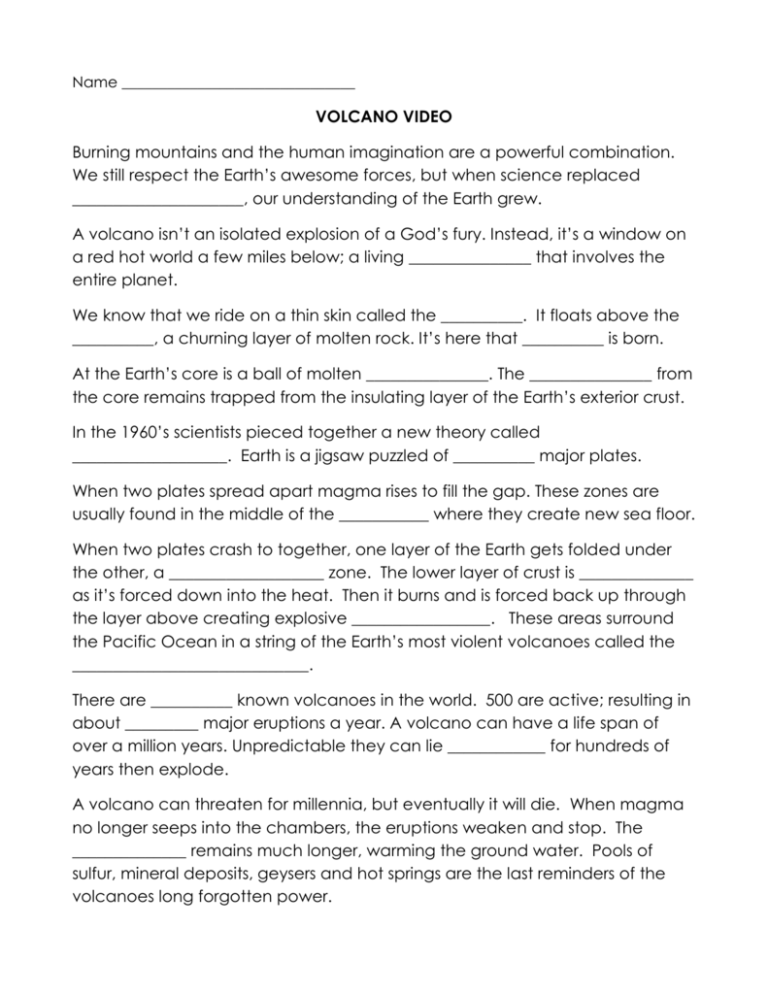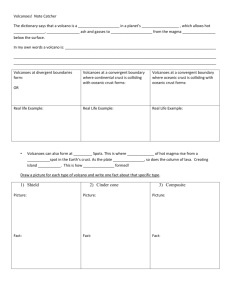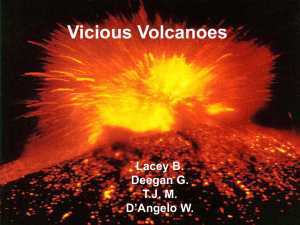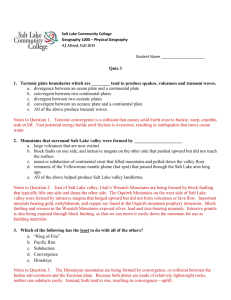Volcano Video
advertisement

Name _______________________________ VOLCANO VIDEO Burning mountains and the human imagination are a powerful combination. We still respect the Earth’s awesome forces, but when science replaced _____________________, our understanding of the Earth grew. A volcano isn’t an isolated explosion of a God’s fury. Instead, it’s a window on a red hot world a few miles below; a living _______________ that involves the entire planet. We know that we ride on a thin skin called the __________. It floats above the __________, a churning layer of molten rock. It’s here that __________ is born. At the Earth’s core is a ball of molten _______________. The _______________ from the core remains trapped from the insulating layer of the Earth’s exterior crust. In the 1960’s scientists pieced together a new theory called ___________________. Earth is a jigsaw puzzled of __________ major plates. When two plates spread apart magma rises to fill the gap. These zones are usually found in the middle of the ___________ where they create new sea floor. When two plates crash to together, one layer of the Earth gets folded under the other, a ___________________ zone. The lower layer of crust is ______________ as it’s forced down into the heat. Then it burns and is forced back up through the layer above creating explosive _________________. These areas surround the Pacific Ocean in a string of the Earth’s most violent volcanoes called the _____________________________. There are __________ known volcanoes in the world. 500 are active; resulting in about _________ major eruptions a year. A volcano can have a life span of over a million years. Unpredictable they can lie ____________ for hundreds of years then explode. A volcano can threaten for millennia, but eventually it will die. When magma no longer seeps into the chambers, the eruptions weaken and stop. The ______________ remains much longer, warming the ground water. Pools of sulfur, mineral deposits, geysers and hot springs are the last reminders of the volcanoes long forgotten power. The last major eruption of Mount Vesuvius was in 1944. It sits over a _________________ zone and ______ still dangerous. A volcanoes origin determines its temperament. Many volcanoes develop along subduction zones. Here the tectonic plates of the Earth’s surface push against one another. Where one plate is rolled beneath another we find the most ________________ volcanoes. They create large ___________ shaped mountains. They have alternating layers of ash, cinders and lava. These layered cones are called ___________________ volcanoes. _________________ islands, like Hawaii, are created when a pool of magma breaks through a ____________ spot in the crust. As it burns the plate moves along 4 inches a year. One island cools as another island is _________________. One the big island of Hawaii, Kileuea has been erupting since 1983 and is showing no signs of stopping. This is an example of a ______________ volcano. __________________ cones are another kind of volcano. Like composite volcanoes they can be explosively violent. They burst forth with enormous quantities of ash, cinders and lava fragments. They rapidly build volcanic _____________________ but never as ____________ as shield volcanoes or as ________________ as composite volcanoes. The cinder cone shape is determined by the size of the ejected material. If we are to reduce the risk of volcanoes, we must learn to _______________ them. The best way to predict a volcano may be to keep an ear to the ground. ___________________ devices can detect the earthquakes that accompany a waking volcano. ___________________ offers new ways to watch the Earth’s imperceptible movements. Lasers and satellites combine to measure the drift of plates and the rise of mountains… inches per year. If movements pick up so might the risk.










